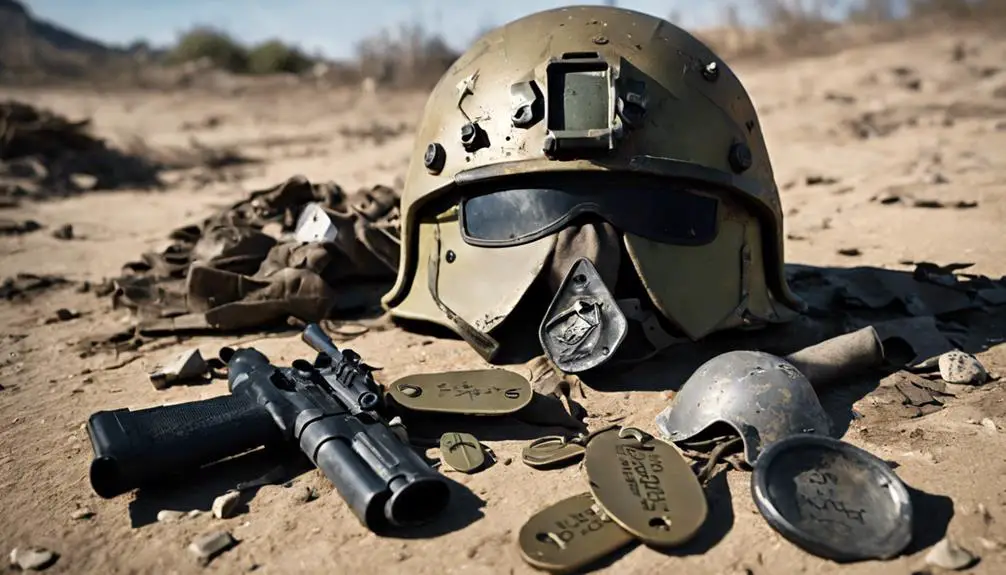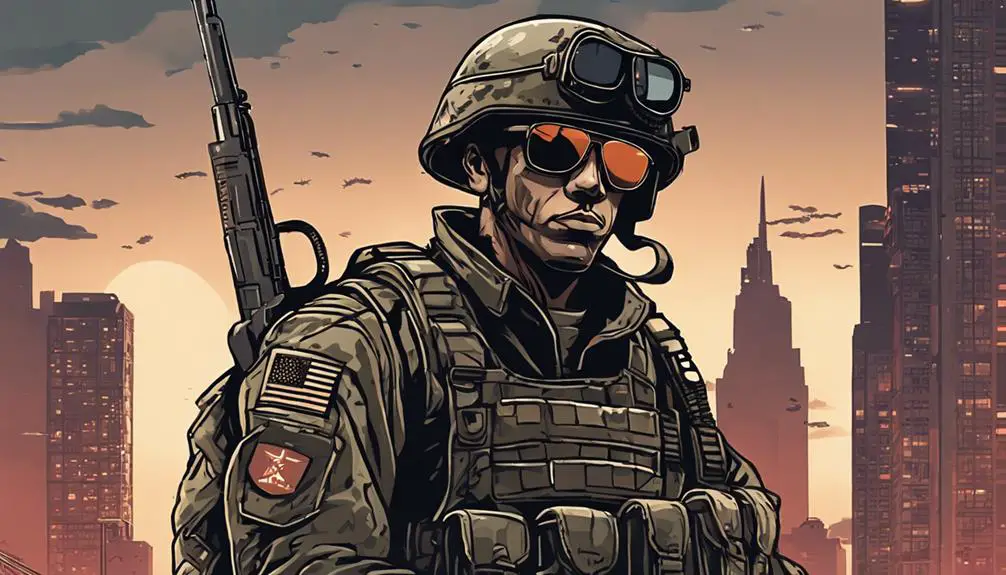You're familiar with military slang like 'Tango' or 'Oscar Mike,' but where did it come from? The origins of this jargon date back to the early 20th century, when soldiers started using derogatory terms to dehumanize enemies, sparking a linguistic pattern that evolved over time. This pattern reflects the roots of radicalism and the evolution of extremism. From Jihadi lingo to covert communication tactics, the language of insurgency has been shaped by the need for secrecy and adaptability. As you explore this complex lexicon, you'll uncover the intricacies of guerrilla warfare and the ways in which language has been adapted to conceal and reveal information.
Origins of Terrorist Terminology

In the early 20th century, the origins of terrorist terminology, particularly in military slang, can be traced back to the World War I era. Soldiers employed derogatory terms to dehumanize and intimidate their enemies, marking the inception of a linguistic pattern that would evolve over time. This phenomenon reflects the Roots of Radicalism and the Evolution of Extremism.
As global conflicts escalated, military jargon adapted to incorporate new terms, often demeaning and degrading, to describe adversaries. This trend persisted through World War II, the Cold War, and subsequent conflicts, with each generation of soldiers contributing to the lexicon of derogatory terms.
The terminology employed was often a reflection of the political and ideological climate of the time. Terms like 'Hun' and 'Kraut' emerged during World War I, while 'Commie' and 'Red' became prevalent during the Cold War. As extremism evolved, so did the language used to describe it, ultimately giving rise to the complex and nuanced terminology we use today to describe terrorist organizations and their ideologies.
Jihadi Lingo and Code Words
You'll encounter a distinct linguistic landscape when delving into the domain of jihadi lingo and code words, where cryptic terminology and deliberate misdirection are employed to evade detection and conceal operational plans. This opaque language is designed to obscure the true meaning of communications, making it challenging for outsiders to decipher.
Cryptic messaging is a hallmark of jihadi lingo, where seemingly innocuous phrases or words convey covert instructions or signals. For instance, a message mentioning 'weddings' might actually refer to a planned attack or operation.
Furthermore, you'll discover that secret handshakes, rituals, and gestures are used to identify fellow operatives or sympathizers. These subtle cues can signal allegiance or authenticate membership within a terrorist organization.
The Language of Insurgency

As you explore the world of insurgency, you'll notice that the language used by rebels and guerrilla fighters is a unique beast. Five distinct linguistic patterns emerge when examining the language of insurgency, each tailored to facilitate clandestine communication and evade detection.
Key Features of Insurgent Language:
- Rebel Rhetoric: Insurgents often employ emotive language to rally support and justify their cause. This rhetoric is designed to inspire loyalty and create a sense of urgency.
- Guerrilla Grammar: Insurgent language often involves deliberate ambiguity and coded messages to avoid detection by authorities. This guerrilla grammar is used to convey secret information without arousing suspicion.
- Adaptability: Insurgent language is highly adaptable, evolving rapidly in response to changing circumstances and security threats.
Covert Communication Tactics
Beyond the linguistic patterns of insurgency, you'll need to master covert communication tactics, which enable rebels to secretly convey and receive information without arousing suspicion. These tactics are essential in guerrilla warfare, where secrecy is key to survival.
One essential technique is secure messaging, which involves using encrypted channels to exchange information. This guarantees that even if messages are intercepted, they can't be deciphered by the enemy.
Deception techniques are also critical, as they allow rebels to mislead their opponents about their plans and intentions. This can be achieved through spreading false information, using coded language, or creating diversions to distract the enemy.
Slang of the Battlefield

Operating in the shadows of guerrilla warfare, rebels have developed a unique slang of the battlefield, which serves as an essential tool for conveying critical information swiftly and discreetly. This coded language allows them to communicate effectively without arousing suspicion from opposing forces. You'll often hear phrases that seem like casual chatter, but are actually packed with meaning.
Here are a few examples of battlefield slang:
- SITREP: Short for 'situation report,' this term is used to request an update on the current battlefield situation.
- Oscar Mike: A phrase used to confirm that a unit is moving out or 'on the move.'
- RTO: Short for 'radio telephone operator,' this term refers to the person responsible for communicating with headquarters.
This slang, also known as Battlefield Banter, serves as a crucial component of rebel communication. It's a language that's constantly evolving, with new phrases and terms being added as the conflict unfolds.
War Clichés, such as 'hitting the ground running,' are also woven into the fabric of this unique dialect. As you explore further into the world of bad guy military slang, you'll begin to appreciate the complexity and nuance of this coded language.
Enemy TTPs and Tactics
You'll need to understand the enemy's tactics, techniques, and procedures (TTPs) to stay one step ahead, as recognizing their modus operandi can mean the difference between success and failure on the battlefield.
To gain this understanding, you'll need to conduct a thorough adversary analysis. This involves gathering and analyzing intelligence on the enemy's tactics, identifying patterns and weaknesses, and anticipating their next moves.
Tactical surveillance is an essential component of this analysis, as it provides real-time information on the enemy's movements and intentions. By combining these efforts, you'll be able to develop effective countermeasures and stay one step ahead of the enemy.
Shadowy Figures and Code Names

In the world of military operations, shadowy figures and code names have long been used to conceal identities and maintain secrecy, and understanding their significance can provide valuable insights into the enemy's organizational structure and communication networks.
As you explore deeper into the world of bad guy military slang, you'll encounter various types of shadowy figures and code names that play essential roles in enemy operations. Here are three key examples:
- Ghost Agents: These are covert operatives who work behind enemy lines, often blending in with the local population to gather intel or conduct sabotage.
- Phantom Units: These are elite special forces teams that operate under the radar, carrying out high-stakes missions with minimal visibility.
- Code Names: These are cryptic labels used to identify specific operations, personnel, or locations, making it difficult for outsiders to decipher their true meaning.
Clandestine Operations Lexicon
Your exploration into the clandestine operations lexicon is essential to deciphering the enemy's secret communications and uncovering their covert strategies. As you immerse yourself in the world of bad guy military slang, you'll encounter a complex web of terminology designed to conceal and deceive.
Covert Insertions, for instance, refer to the stealthy deployment of agents or assets into hostile territory, often under the guise of humanitarian or diplomatic missions. These operations require meticulous planning and execution to avoid detection, making them a hallmark of sophisticated clandestine operations.
Shadow Agents, on the other hand, are highly trained operatives who blend into their surroundings, assuming false identities and cover stories to gather intel or execute high-stakes missions. Their existence is often denied or disavowed by their sponsoring organizations, making them virtually untraceable.
Frequently Asked Questions
What Motivates Individuals to Adopt Violent Extremist Ideologies?
You're likely wondering what drives individuals to adopt violent extremist ideologies. Radicalization theories suggest that social pressures play a significant role.
You see, when people feel marginalized or disenfranchised, they may seek a sense of belonging and purpose in extremist groups. Social pressures, such as peer influence or charismatic leaders, can then reinforce these beliefs, leading individuals down a dangerous path.
It's essential to understand these factors to develop effective counter-narratives and prevention strategies.
Can Former Extremists Be Successfully Rehabilitated and Reintegrated?
Imagine you're traversing a treacherous maze, where one wrong turn can lead to catastrophe. That's the path former extremists often face. Can they find their way back to society?
The answer lies in deradicalization programs, which aim to dismantle harmful ideologies and rewire minds. Effective social reintegration is essential, as it helps individuals rebuild their lives and reconnect with their communities.
You'll find that successful rehabilitation requires a multifaceted approach, involving counseling, education, and community support.
How Do Terrorist Groups Fund and Finance Their Operations?
You're likely wondering how terrorist groups fund their operations. The answer lies in their illicit activities. They often engage in criminal enterprises, such as extortion, kidnapping, and illegal trafficking of goods and people.
These ventures generate significant revenue, which is then used to finance their terrorist activities. Additionally, they may also exploit natural resources, like oil or minerals, to fuel their operations.
What Role Do Women Play in Modern Terrorist Organizations?
You're about to explore the hidden dynamics of modern terrorist organizations. Imagine a labyrinth, where women navigate through the shadows, playing multifaceted roles. They're not just victims or bystanders; they're active participants, taking on various responsibilities.
Female operatives are increasingly involved in logistical, financial, and even combat duties. Gender roles are blurring, and you'll find women in leadership positions, recruitment, and even suicide missions.
As you investigate further, you'll discover the complexities of their involvement and the motivations driving their actions.
Can AI and Machine Learning Tools Detect and Prevent Terrorist Activities?
You're wondering if AI and machine learning tools can detect and prevent terrorist activities. The answer is yes, they can.
Predictive algorithms can analyze vast amounts of data to identify patterns and potential threats. Cyber surveillance can also be used to monitor online activities and identify suspicious behavior.
Conclusion
As you explore the shadows of military slang, the terminology of terrorism unfolds like a dark tapestry, woven with threads of secrecy and deception.
You've navigated the labyrinthine world of jihadi lingo, covert communication tactics, and clandestine operations.
Now, the lexicon of insurgency and enemy TTPs lies before you, a complex puzzle waiting to be deciphered.
The language of the battlefield echoes in your mind, a haunting reminder of the sinister forces that lurk in the darkness.







